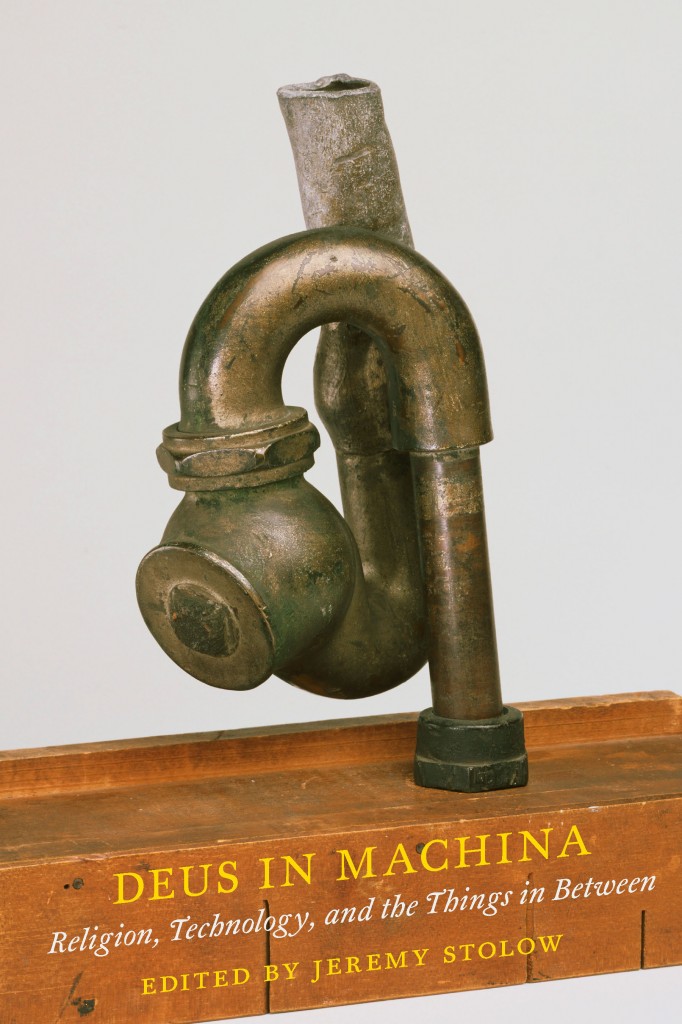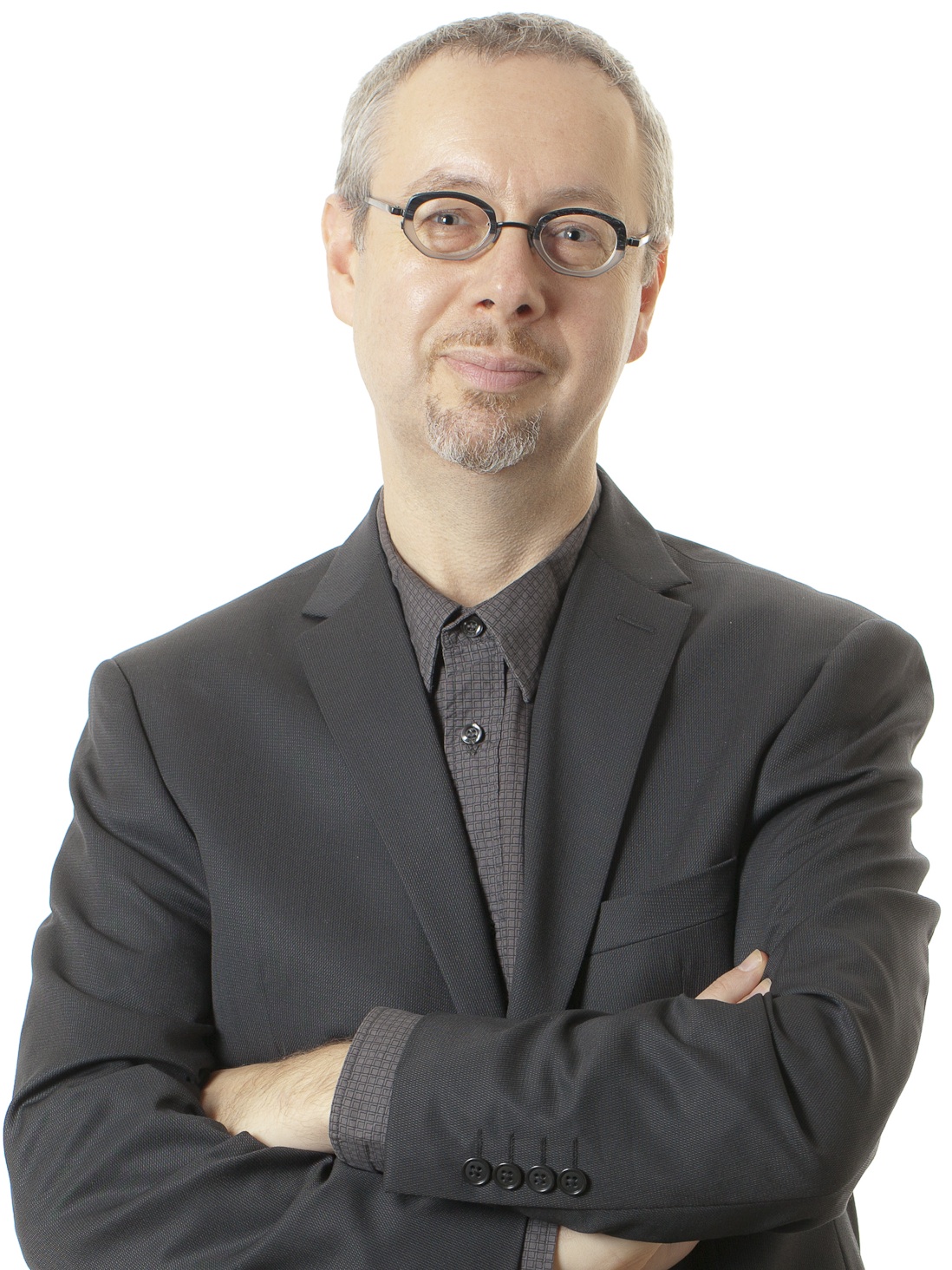Deus in Machina: Religion, Technology, and the Things in Between, ed. Jeremy Stolow (New York: Fordham University Press, 2013).
The Revealer is excited to have a clip from the introduction to Jeremy Stolow’s collection of essays: Deus in Machina: Religion, Technology, and the Things in Between. Stolow, now an Associate Professor in the Department of Communications at Concordia University, served as a fellow here at the NYU Center for Religion and Media from 2003-2004. It was while with us, as he notes in the work’s acknowledgements, that Jeremy planted the intellectual seeds for the impressively thought-provoking collection. Deus in Machina explores the complex intermingling of the realms of religion and technology. In one chapter, we find ourselves situated in pre-modern Buddhist Japan, dabbling in the healing powers of prayer. In another, we are confronted by the Islamic debate surrounding kidney dialysis in present day Egypt. Both apt and timely, Deus in Machina explores what is at stake while living in a world where religion and technology, realms that were both once thought of as explicitly distinct from one another, seem to be increasingly and inextricably bound by one another.
Here’s an excerpt from the introduction to Jeremy Stolow’s Deus in Machina:
In ancient Greek tragedy it was not uncommon to resolve a particular dramatic crisis with the sudden intervention of a god, a strategy with which the playwright Euripides had a particular affinity. At the appointed moment during the play performers would utilize a trapdoor in the floor of the stage or employ a mechanê, a sort of crane with a pulley attached to it, to lower, raise, or exhibit motionless in midair a statue or an actor dressed as a deity, often the god Zeus. Such a miraculous apparition would interrupt the dramatic events taking place on stage, typically for the purpose of rescuing characters from an impending doom.1 But this dramaturgical convention, apò mechanês theós (“the god out of the machine”), was denigrated by a long line of critics, starting with Aristotle, who lamented playwrights’ overreliance on such a cheap and “merely mechanical” resolution of dramatic tensions.2 In this tradition the convention of apò mechanês theós and its Latin calque, deus ex machina, came to refer to any formulaic use of a plot device in which a conveniently perfect solution emerges for an otherwise inextricable problem in the story through the insertion of an entirely unexpected character, object, or event. Underlying the critics’ longstanding disdain for the employment of deus ex machina, perhaps we might note an even deeper disdain for mechanical manipulation. Apparently, authentic divine presence, if it is to remain authentic, is not supposed to manifest itself as an instrument in the service of the human hand. Wherever we think we see gods sprouting out of our tools and machines we are merely bearing witness to the fruits of our own human labor, and only a poor poet (or a gullible spectator) would suppose otherwise. There is in fact a long history of association of the word machina with abject notions of trickery and deceit, as evident in the Latin verb machinari, “to invent, contrive, or devise,” a reference still preserved in the English noun machination: a crafty scheme designed to accomplish a sinister end.3 Here, perhaps, is one archaic trace preserved in the modern conception of religion as an ideological mechanism brought to bear upon superstitious populations by an impudent and cunning priesthood, as proposed by David Hume in his Natural History of Religion (1757), Ludwig Feuerbach in his Lectures on the Essence of Religion (1851), and Emile Durkheim in his Elementary Forms of Religious Life (1912), to name but three figures within a crowded lineage of scholars dedicated to exposing the machine hiding behind our ghostly illusions.
The title of this book, Deus in Machina, purposefully inverts the presumed relationship between divine entities and the mechanisms that render them present. Rather than foreclosing discussion about whether and how one must choose between human-built machines and the authentic presence of gods, spirits, and other transcendent forces and things, this book seeks to revisit and revise the very supposition that religion and technology exist as two ontologically distinct arenas of experience, knowledge, and action. In common parlance, the word religion typically refers to the intangible realms of ritual expression, ethical reasoning, affect, and belief, whereas the word technology points to the material appurtenances, mechanical operations, and expert knowledge that enable humans to act upon, and in concert with, the very tangible domains of nature and society. The locution religion and technology thus operates alongside a series of analogous binaries, including faith and reason, fantasy and reality, enchantment and disenchantment, magic and science, and fabrication and fact. To talk about religion and technology, therefore, would appear to be a relatively straightforward matter of properly deploying the “and” that conjoins the two terms. Religiously derived emotions, beliefs, ethical motivations, and performative repertoires can be added to—or subtracted from—the otherwise independent operations of technologies that do their work “in the real world,” producing their effects in accordance with established laws of physics. Religious actors can embrace, avoid, reject, or repurpose technologies; they can tell stories about the sources of inspiration that led to their creation; they can develop their own vocabularies to describe how and why they work; and they can even come to regard the things they or their fellow humans built with their own hands as idols, fetishes, talismans, or transubstantiations of ordinary matter into sacred matter. But technology refers to an order of things existing outside of and independent from all such dispositions, uses, and frameworks of meaning, and there is not supposed to be anything allegorical about the work technologies perform or the things they can or cannot do.
However, as Bruno Latour reminds us, it is not so easy, nor is it so desirable, to distinguish between reality and its construction. Facts about the natural world have always only come to us through the work of fabrication: through controlled modes of experimentation and observation and through the social allocation of credibility and expertise. And yet, once constructed, these facts manage to erase their own origins in order to present themselves, quite magically, as things that have been merely discovered, not made. For Latour it is this process of construction and denial of constructedness that brings the “real” world of technoscience into curiously close alignment with the “illusory” universe of idol-worship, fetishism, and other acts of bearing witness to transcendent powers of miracle, magic, and fate. One of the aims of this book is to take seriously Latour’s attempt to shake us free from the ingrained wisdom that presumes there is a clear and unproblematic divide between reality and construction— or, as Latour provocatively suggests, between fact and fetish—in order to immerse ourselves in a labile, category-confusing universe of “autonomous creations,” including such things as “lactic acid ferments, divinities, black holes, tangled genes, apparitions of the Virgin, and so on. What do we have to lose? What are we afraid of?”5 In a similar vein this book asks: Is it still useful—is it still even possible—to imagine that religion and technology can be parceled out as two discrete dimensions of the cosmos? What is at stake in the provocation of this book’s title to locate “god in the machine?” Who has the authority to weigh those stakes? What might be gained or lost once religious and technological things are allowed to mingle promiscuously with one another?
Deus in Machina
CONTENTS
List of Illustrations vii
Acknowledgments ix
Introduction: Religion, Technology, and the Things in Between
Jeremy Stolow 1
EQUIPMENT
Calendar, Clock, Tower
John Durham Peters 25
Ticking Clock, Vibrating String: How Time Sense Oscillates Between Religion and Machine
Wolfgang Ernst 43
The Electric Touch Machine Miracle Scam: Body, Technology, and the (Dis)authentication of the Pentecostal Supernatural
Marleen de Witte 61
The Spiritual Nervous System: Reflections on a Magnetic Cord Designed for Spirit Communication
Jeremy Stolow 83
BIO-POWER
An Empowered World: Buddhist Medicine and the Potency of Prayer in Japan
Jason Ananda Josephson 117
Does Submission to God’s Will Preclude Biotechnological Intervention? Lessons from Muslim Dialysis Patients in Contemporary Egypt
Sherine F. Hamdy 143
The Canary in the Gemeinschaft? Disability, Film, and the Jewish Question
Faye Ginsburg 159
(RE)LOCATING RELIGION IN A TECHNOLOGICAL AGE
Thinking about Melville, Religion, and Machines That Think
John Lardas Modern 183
Amazing Stories: How Science Fiction Sacralizes the Secular
Peter Pels 213
Virtual Vodou, Actual Practice: Transfiguring the Technological
Alexandra Boutros 239
TV St. Claire
Maria José a. de Abreu 261
Jeremy Stolow is an Associate Professor in the Department of Communication Studies at Concordia University, Montréal, Canada. He is also a member of the International Advisory Board of the Center for Religion and Media (New York University), and a member of the Centre de recherche sur l’intermedialité (Université de Montréal).
To stay up to date on Deus in Machina events and information, like here: http://www.facebook.com/stolowdeusinmachina
Excerpt selected and introduced by Christopher J. Smith.
Images via jeremystolow.com
________________________________________________
1. See Donald J. Mastronarde, “Actors on High: The Skene Roof, the Crane, and the Gods in Attic Drama,” Classical Antiquity 9, no. 2 (October 1990): 247–94; Rush Rehm, Tragic Greek Theatre (New York and London: Routledge, 1994), 69–71.
2. See, for instance, Aristotle, Poetics 1454a–b.
3. Whereas in ancient Greek the term mechanê still reverberated with the connotations of its root word, mekhos (literally a “means” or an “expedient,” etymologically connected to the proto-Indo-European word magh-, “to be able,” whence also comes the term “magic”), by Roman times the word machina already had expanded its semantic terrain to include “device,” “frame,” “contrivance,” and “trick.”
4. David Hume, Dialogues and Natural History of Religion, ed. J. C.
A. Gaskin (1757–1779; Oxford: Oxford University Press, 1993); Ludwig Feuerbach, Lectures on the Essence of Religion, trans. Ralph Manheim (1851; New York: Harper and Row, 1967); Emile Durkheim, The Elementary Forms of Religious Life, trans. Karen E. Fields (1912; New York: Free Press, 1995).
5. Bruno Latour, On the Modern Cult of the Factish Gods (Durham, N.C.: Duke University Press, 2010), 43; see also Latour, “What Is Iconoclash? Or Is There a World Beyond the Image Wars?” in Iconoclash: Beyond the Image Wars in Science, Religion, and Art, ed. Latour and Peter Weibel (Cambridge, Mass.: MIT Press, 2002), 14–37; Latour, Pandora’s Hope: Essays on the Reality of Science Studies (Cambridge, Mass.: Harvard University Press, 1999), 266–92.



